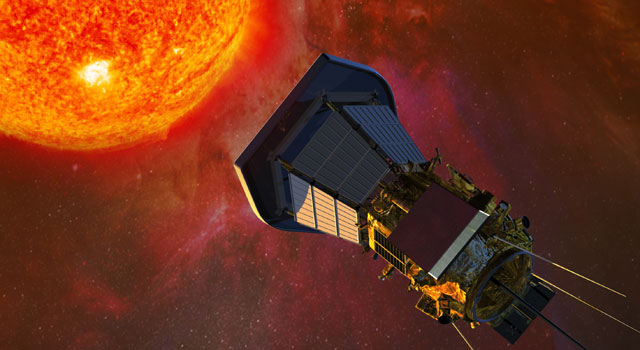
This astronomers’ dream is as old as the conquest of space : to explore in situ the solar corona, source of the solar wind, this plasma of electrons and protons which bathes the solar system, and whose interaction with our planet drives space meteorology and produces polar auroras. Space probes have explored the solar system and reached its outer frontier at more than ten billions kilometres. But never the inner region, within Mercury orbit, and two fundamental questions are still unsolved (Figure 1) : how can the corona be so much hotter than the visible surface of the Sun ? And how does the solar wind blow at a supersonic speed of nearly one thousand kilometres per second ? These questions concern not only our Sun, but also many stars having a hot corona and a wind. They imply a fundamental problem of plasma physics : how is energy transported in these turbulent media which are so far from local thermal equilibrium ?
The Solar Probe Plus, to be launched in 2018, not larger than a small car, should be able to withstand temperatures exceeding 1000°C and blasts of intense radiation. A heat shield using novel technology will protect its instruments during the passages close to the Sun, at only 6.5 millions kilometres - less than ten solar radii.

The probe will carry four suites of instruments. Among them, those of the consortium FIELDS, led by the Space Sciences Laboratory of University of California, which has been selected among thirteen proposals. This experiment will measure the electric and magnetic fields using receivers which should be built respectively at LESIA (1) and LPC2E (2) (with support from CNES), to study in situ coronal electrons, radio emissions, plasma waves, shock waves and turbulence, as well as dust grains. The selection of the LESIA instrument is the result of a long-standing theoretical and instrumental research performed at Observatoire de Paris with the support of CNRS and CNES, to transform electric antennas connected to a sensitive radio receiver into giant detectors of electrons and dust. This work has implied a close collaboration between scientists and engineers, and the theoretical and instrumental developments have implied seven doctoral theses. The principle is simple and has been tested on a number of space missions in various solar system environments. The thermal motions of electrons around the antennas induce electric fields which are detected by the radio receiver. A spectral analysis then reveals basic properties of the electrons, as their concentration and temperature (3). The radio receiver also detects the dust grains that impact the spacecraft, producing microcraters and ionisation which induces electric pulses (Figure 3).

(1) Observatoire de Paris, CNRS, Universités UPMC et Paris Diderot, 92195 Meudon Cedex
(2) Observatoire des Sciences de l’Univers en région Centre, Université d’Orléans
(3) http://lesia.obspm.fr/Spectroscopie-du-bruit-quasi.html
(4) Meyer-Vernet et al., 2009, Solar Phys. 256, 453
(5) http://lesia.obspm.fr/SORBET-sur-MMO-BEPICOLOMBO.html (6) http://lesia.obspm.fr/Solar-Orbiter.html
